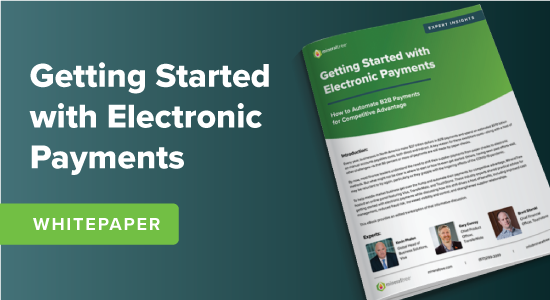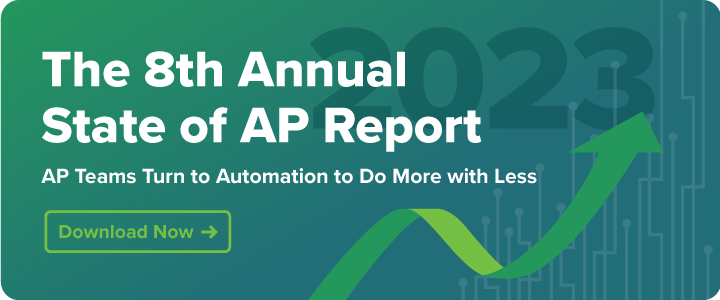Payment automation is the use of technology to automate the process of making and receiving payments, such as by automating invoicing, payment tracking, and account reconciliation. Outdated manual processes can bring an AP workflow to a halt. Invoices can go missing or get bottlenecked during the approval process, information may be entered incorrectly, and payments may be delivered late or for incorrect amounts. However, by automating your payments, you can not only streamline your workflow, but reduce fraud, improve supplier relationships, and even save money. We’ll discuss the ins and outs of payment automation, including six ways it can improve your AP workflow.
What is Payment Automation?
Payment automation is the use of software to automate the process of paying suppliers. In general, payment automation goes beyond just automating the payment approval process and includes the actual sending of the payment itself. These automated payments may be sent in the form of an ACH transaction, wire transfer, virtual card payments, a check, a cross-border or FX payment, or another payment form.
By eliminating time-consuming and error-prone manual AP processes, payment automation allows vendors to get paid faster and helps streamline the entire AP workflow. AP employees are then free to spend their time on more creative and complex tasks.
How Do You Automate Payments?
The act of automating payments is often best implemented as part of a larger AP automation solution. End-to-end AP automation doesn’t just include automation of payments and payment authorization, but automated invoice capture, coding, and approval as well. This generally requires the adoption of software or a platform that can handle all associated processes.
At the payment authorization step, automation may involve encoding rules in the software program to release payment. Under a manual process, the AP manager submits a payment run or batch of payments and the payment authorizer decides which payments to release and which to hold or reject. However, if the person releasing the payment is out of the office, this can extend payment time, creating one of the biggest bottlenecks in the manual process.
With automation, an invoice payment can be accepted or rejected from any device as approvers work at the office, at home, or on the road. At this point, the payment authorizer can also make a decision around when to schedule the payment, for instance pushing it out to the due date to hold on to cash for a bit longer or to pay early to capture a discount.
During the payment execution part of the automated process, approved payments are scheduled and then sent. Once payment occurs, details sync back to your accounting system and the invoice is closed. In addition, all records of approval, copies of the invoice, receipts, and payment records are all linked to the invoice so that anyone who needs to look into the transaction in the future can find all related information in one place.
Why Is It Beneficial to Automate Payments?
We’ve already mentioned that automation can streamline the AP process and reduce errors, but the benefits go far beyond that. Here are six ways that payment automation improves your AP workflow:
1. Reduced Fraud Risk
By automating payments, you are building simple and repeatable payment controls into everyday AP processing. These controls include segregation of duties, dual-factor authentication, and payment tokenization, all of which add extra layers of security. Maintaining the integrity of payment protocols helps reduce fraud risk and keeps company financial information from falling into the wrong hands.
Automation also often eliminates the need for paper checks by instead relying on electronic forms of payment. Paper checks are the primary target of those who commit fraud.
2. Scale Your AP Team
Once members of your AP team no longer have to process payments manually, they can be assigned other tasks or turn their efforts toward more creative endeavors. You may even be able to scale your team back to save labor and infrastructure costs. Alternatively, you’ll be able to handle a much larger influx of invoices as your company grows without needing to increase your number of employees. In fact, 61% of teams who had implemented AP automation were able to process more invoices with the same size team. 25% of respondents reallocated the time spent processing invoices to other projects.
3. Better Supplier Relationships
Vendors are happiest when paid on time and when there is transparency into the payment process. Automation ensures both faster payment and often better record-keeping — thus improving supplier relationships. Relationships with vendors have grown more important over the last year, according to 71% of respondents. For specific industries, such as healthcare, this number is even higher with 75% of respondents citing the increasing importance of these relationships.
Some systems, such as MineralTree, even have vendor self-service portals that allow vendors to view the status of pending invoices and payments , as well as view and download remittance data for easier payment reconciliation. Keeping vendors happy not only reduces the number of calls or uncomfortable encounters but also reduces churn and generates trust, leaving the door open for strategic negotiation.
4. Improved Efficiency in a Hybrid Environment
Manual, paper-intensive AP processes don’t mesh well with hybrid work environments. If approval requires physically handing an invoice from one person to another when some individuals are working remotely and others are in the office, it can quickly bring the process to a halt.
Also, check payments require that AP team members be physically present to print and mail the payments. Automation, however, handles many of these tasks electronically and automatically. Approval can happen from anywhere and on any device, creating a more streamlined approach to invoice payment.
5. Reduced Costs
Automation makes it easier to stay on top of all payment deadlines, including early-pay discount deadlines which directly reduce overall costs. By ensuring on-time or early payment, you’ll also avoid late fees. The automated tasks themselves also eliminate labor costs associated with manual processes. Printing and mailing costs associated with check payments are also eliminated.
By enabling electronic payments automation, businesses can hang on to large sums of capital as long as possible before using them to cover payments, which extends the company’s working capital. Some electronic payment options, like virtual cards, may even have rebates that further add to the cash flow.
6. Pay Invoices More Quickly
Payment automation enables faster invoice payment in two ways. First, because automation streamlines approval and authorization, an invoice goes from received to ready-for-payment much faster. Second, because most automated payments are electronic, the vendor receives funds much quicker, instead of having to wait for a check to arrive in the mail.
Payment Automation Case Studies
Many businesses have realized tangible positive results by automating payment processes. Learn more about each of these success stories below. :
Affinity Dental Uses AP Automation to Scale
Affinity Dental Management turned to MineralTree for a solution that would help them handle payments during a time of rapid growth. Automation enabled them to eliminate manual data entry, improve electronic payment capabilities, reduce costs, and improve visibility and control.
Dynacraft Uses Automation to Streamline their AP Process
Dynacraft, a distributor of bicycles, scooters, and other wheeled items, used automation to turn a disjointed, manual, and paper-based process into something centralized, streamlined, and paperless AP process.
The Appalachian Mountain Club Approves Its Invoice Approval Process
The Appalachian Mountain Club (AMC) used automation to improve its ability to approve invoices with a geographically dispersed team. AMC’s AP process is now much more efficient and they’re able to take advantage of rebates and other incentives.
Bayard Advertising Used Automation to Improve Transparency and Control
Bayard Advertising sought an automation solution for quicker invoice turnaround and improved transparency and control. Adopting MineralTree helped them not only realize these benefits but made the transition to remote work during the COVID-19 pandemic much less fraught.
How End-to-End Accounts Payable Automation Helps Facilitate Payments
Automating all steps of the AP process amplifies the benefits of automating payments. The end-to-end process begins with invoice capture, which can be handled automatically in a number of ways. Optical Character Recognition (OCR), for example, can extract information from invoices received via the dedicated inbox as well as paper invoices that are scanned and uploaded to the system.
Once in the system, automation can route invoices to the right people for approval and authorization, which is followed by authorizing and sending the payment. But that’s not all. Tools like MineralTree Total AP can automate this entire process and also collect important data that populate real-time dashboards and enable visualization of metrics and KPIs such as invoice aging, payment mix, and rebates.
Additionally, with end-to-end automation, the goal is to go beyond payment automation to payment optimization through managed services such as supplier enrollment. These services take on the responsibility of enrolling suppliers to accept electronic payments and then handling payment inquiries and issues.
MineralTree’s complete end-to-end solution also provides complete visibility across the entire accounts payable workflow while streamlining the entire process. Interested in learning more? Request a demo and explore how AP automation can help your organization work more efficiently and gain confidence that all invoices are being processed safely, and on time.
Frequently Asked Questions:
How Does Automated Accounts Payable Work?
Accounts Payable automation eliminates outdated manual processes that leave companies susceptible to fraud, lost invoices, and overdue payments. The end-to-end automation process includes invoice capture, approval, and payment execution.
What is Vendor Payment Automation?
Vendor payment automation involves automating the authorization and sending of payments to vendors via software integrated with your ERP and bank. Check payments are automated, removing the burden of cutting checks from your team. ACH payments are deposited directly into vendor accounts within just a few business days of authorization. Virtual cards are even faster, making same-day digital payments a reality.
How Do Companies Improve Their Payment Processing?
Companies can improve their payment processing with automation. The leading AP automation solutions make it easy to manage and monitor invoice processes, improve efficiency, and identify any invoices that need special attention.





